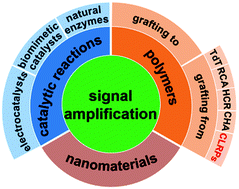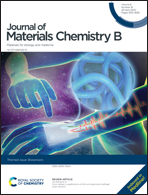Controlled/“living” radical polymerization-based signal amplification strategies for biosensing
Abstract
Controlled/“living” radical polymerization (CLRP) techniques, such as atom transfer radical polymerization (ATRP), reversible addition–fragmentation chain transfer (RAFT) polymerization, and their variants, have now emerged as a novel class of signal amplification strategies and they have attracted growing attention in biosensing of clinically relevant biomolecules. Through the CLRP-mediated de novo formation of polymer chains, a large amount of signaling probes (e.g., ferrocene) or functional groups (e.g., –NH2, –CHO, and –COOH) that are available for the subsequent introduction of signaling probes can be recruited in the sensing interfaces, outputting a high signal even in the presence of a low abundance of target analytes, thereby greatly improving the detection sensitivity. Compared with conventional strategies based on the use of either catalytic labels (e.g., natural enzymes, biomimetic catalysts, and electrocatalysts) or complex nanomaterials (e.g., surface-functionalized metal nanoparticles), CLRP-based signal amplification strategies have advantages of being low-cost, highly efficient, and relatively easy in operation. By virtue of these merits, CLRP-based signal amplification strategies show great promise for clinical applications and biomedical research studies. In this review, the advantages and disadvantages of various signal amplification strategies have been summarized. Following a brief introduction of the mechanisms of various CLRP techniques, a comprehensive overview of the applications of CLRP-based signal amplification strategies in biosensing of clinically relevant biomolecules such as nucleic acids, enzymes, and antigens is presented. Also discussed herein are the advantages and disadvantages of CLRP-based signal amplification strategies, which are believed to be instructive for their broad application in biosensing.

- This article is part of the themed collection: Biosensors


 Please wait while we load your content...
Please wait while we load your content...